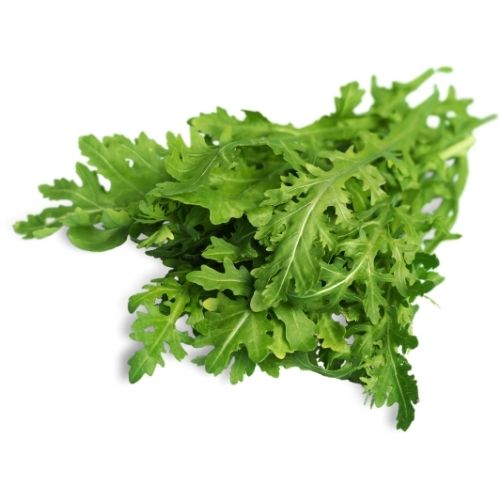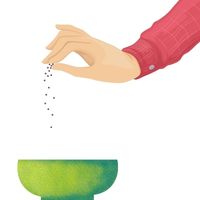
Botanical name : Eruca sativa
Flavor Profile : Nutty, Peppery, Bitterness increases with age
A bit tangy in taste, Arugula is a mainstay ingredient in Mediterranean cuisine since ancient Roman culture. Additionally, they believed it had aphrodisiacal properties. It is also known by many names such as rucola, roquette, Italian cress, and rocket.
Until the 1990s, Americans ignored arugula because of its strong, peppery taste. However, in recent years, the herb is being used to make a wide variety of foods, including garnishing herb, salad greens, and even as vegetables.
In salads, arugula’s flavor adds zest to romaine, spinach, and butter lettuce, which generally have a mild flavor. As arugula cooks, it loses some of its spicy flavor and takes on a mild taste. To ensure maximum flavor, add arugula at the end of cooking.
Health benefits of Arugula
As a relative of cabbage, broccoli, cauliflower, horseradish, and mustard greens, arugula is an incredibly nutritious cruciferous vegetable. It is a rich source of vitamins A, C, E, and K, as well as minerals like calcium, iron, and potassium. For more nutrition and caloric value details, please check the link HERE.
How to grow Arugula indoors
Arugula is an annual herb. During late spring and early fall, arugula grows best in cool temperatures. Arugula leaves harvested at the peak of summer will have a spicier taste and more flavor, since the plants’ flavor intensifies when they flower.
Mid spring to early fall is the preferred time to saw arugula seeds.
Plant size

6 – 12 inches ( 15 -30 cm )
Container / pot Size

6 inches Diameter ( 15 cm )
Refer how to choose the right container for your indoor plants for more details
Sunlight

Partial shade. Spring is the best time to plant the container in full sun. However, as summer approaches, it should be moved to cooler, shadier locations until the plants bolt or the leaves become too strong to tolerate.
Refer Best locations and Light requirements for indoor plants for more details.
Soil

Fertile, rich and well drained potting mix. A soil temperature of 40 to 55 degree Fahrenheit (5 to 12 degree Celsius) is considered ideal for growing arugula indoors. Arugula plant also prefers slightly acidic soil.
Sowing

Can be sown by seeds or young plants from nursery. Plant seeds 1/2 an inch deep in the potting mix. Arugula seedlings will start appearing within 3-5 days. Keep the soil moist in case you are planting arugula seeds in warm or hot weather.
2-3 seeds per inch is a good distribution for sowing arugula seeds. You can also put 15 seeds per inch in case you plan to grow arugula for the purpose of harvesting micro greens.
Quick tip: Place a wet paper towel above the soil to prevent it from getting dry. This will lower the surface temperature of the soil and prevent moisture to escape from the soil.
Watering

On regular basis. Whenever the soil feels dry to the touch.
Harvesting

Cut arugula leaves as needed or gather whole plants. You can begin harvesting when leaves are large enough to handle and plants have grown large enough so that there will be some left over for future harvests.
It is advisable to remove the outermost leaves first, since the inner ones will continue to grow throughout the season. Harvest regularly in order to encourage new growth.
As soon as the weather gets hot, the leaves become tough and unpleasantly peppery. As the season wears on, arugula may bolt (producing flowers and seeds fast skipping the production of harvestable foliage). The creamy yellow flowers, shot through with violet veins, make a tasty salad topping, even though the foliage is not very flavorful at this point.
Plant care

Provide shade for arugula plants, especially in the afternoon, when the sun is strong and hot. Adding compost to the potting soil can improve its nutrient content and moisture retention.
SUBSTITUTES FOR ARUGULA IN THE KITCHEN
- Baby Spinach with a pinch of pepper
- Dandelion greens
- Endive
- Escarole
- Radicchio
- Watercress
How to keep arugula fresh
Wrap the roots of arugula leaves in a moist paper towel. Placed it in a plastic bag, and placed in the crisper section of the refrigerator.
To store just the leaves, layer them with paper towels to keep them as dry as possible, place them in a zip-tight plastic bag, and store in the crisper. Avoid freezing or drying Arugula.
Please refer to how to store herbs and spices for more details.
How to use arugula in the kitchen
In addition to cheeses like Parmesan and Gorgonzola, fresh fruit like oranges and pears, and potato dishes, arugula offers a tangy counterpoint to big-flavored foods like omelets and potatoes.
Prepare the leaves by sautéing or steaming them, then serve them alongside fish, poultry, or meat.
Dishes : Sauces, soups, Pizza, Pasta, salads, pasta and sandwiches.
Preparation : Used as whole leaves.
Pairing arugula with food
Seasoning : Red Chili flakes, Olives ( Green olives, black olives ), Lemon juice, Garlic, Parsley, Chives, Balsamic vinegar, Pepper.
Fruits and Vegetables : Potatoes ( White Potato, Red Potato, Russet Potato, Purple Potato ), Oranges, berries ( Blackberries, Blueberries, Acerola Cherry / Barbados Cherry, Cranberries, Cherries, Elderberries, Mulberries ), lettuces (Romaine lettuce, leaf lettuce, iceberg lettuce) citrus, mushrooms (Enoki Mushroom, Morel Mushroom, White Mushroom / Button mushroom, Cremini Mushroom, Portabella Mushroom, Shiitake Mushroom, Maitake Mushroom, Chanterelle Mushrooms, Oyster Mushroom) pears, avocado, onions, beets, tomatoes, corn
Proteins : Chicken, veal, fish and seafood, cheeses, nuts, prosciutto, beef, eggs

